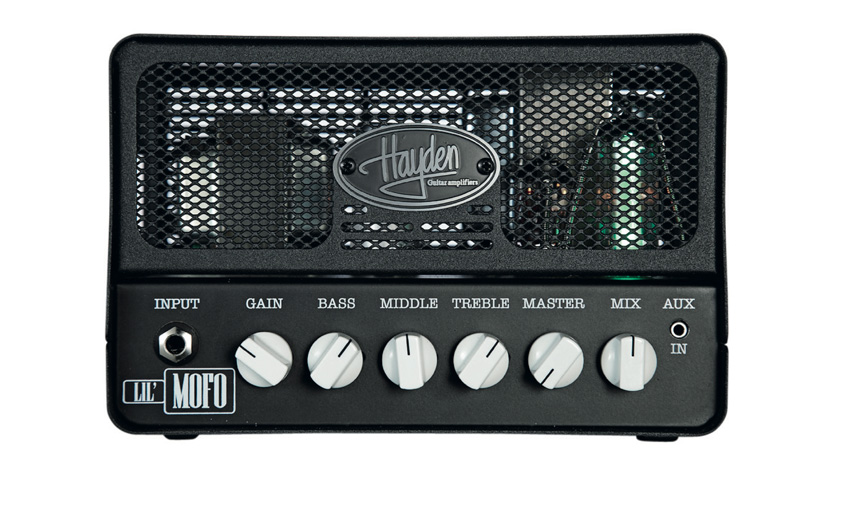MusicRadar Verdict
There's very little to grumble about and for grab- and-go use this head is excellent.
Pros
- +
Great tone and player-friendly response. Overall performance is excellent.
Cons
- -
Not much.
MusicRadar's got your back
Since 2006, Ashdown - the UK brand of world-class bass amp fame - has marketed its guitar amplifier range under the name of Hayden, a unique and separate identity. It's a tough market, but Hayden has gradually been winning acclaim on both sides of the Atlantic. Here we're looking at an amp from the recently revamped MoFo range: the 15-watt Mini MoFo.
"It's a tough market, but Hayden has gradually been winning acclaim on both sides of the Atlantic"
First impressions are all-important and this head scores highly in the design, fit and finish departments. Top marks to Hayden for the restyling: the smart, purposeful case is folded steel with a black crackle finish that seems reasonably hard-wearing, and there's plenty of ventilation integrated into the covers, as well as a useful handgrip or two.
The chassis supports oversized mains and output transformers, which, at first glance at least, would indicate good things for tone. Inside, the electronics are mostly contained on one large high- quality through-plated PCB that holds the valve bases and front panel controls. The mains switch and socket are chassis-mounted on the rear panel, and what little wiring there is has been neatly executed.
In terms of its shouting voicings, the Mini MoFo's power section comprises two EL84 valves - made famous, of course, by classic British amps including the Vox AC30, but also put to great use these days in amps including the Fender Blues Junior, among many.
In addition to an ECC83 driver, there's one other valve that's common to all of the new MoFo heads - an EM84 'magic eye'. Magic eye valves date back to the early days of radio when they were used as tuning aids, with a fluorescent 'cat's eye'- shaped display in the top of the valve that would move as stations were tuned in and out.
It's generally thought that Radio Corporation of America originated the 'magic eye' name. The EM84 has a dual-bar green display on the side and featured in many 1960s domestic reel-to-reel tape recorders as a level indicator. In the new Hayden MoFos, it's reincarnated as a cool status light, with both green bars moving up and down as you hit the strings: not exactly an essential inclusion, but very stylish nonetheless.
All of the new range of MoFo amps are single-channel designs when it comes to their front ends, with controls for gain, bass, mid and treble, plus an overall master volume. The Mini MoFo also offers a power reduction switch that reduces the output from 15 to just two watts.
Overall, this MoFo is built to last, with porcelain valve bases, quality neon-illuminated mains rocker switches, and stylish metalwork that's at least as good as anything we've seen from the competition.
Sounds
We tried out this new MoFo with a pair of Vintage 30-equipped 2x12 open- and closed-back cabinets, with a selection of guitars, including a Gibson Les Paul Studio, a PAF- equipped Les Paul Standard, a Fender Custom Shop Nocaster, and our regular Alnico Pro-loaded Strat.
While this head doesn't offer much in the way of clean headroom, it's not lacking in punch, and at 15-watts, the Mini MoFo is certainly viable for smaller gigs with a suitable extension cab and a well-mannered drummer.
With gain and master volume set at around halfway, the Mini maintains enough headroom and dynamic range to cut through an averagely loud band mix and cleans up nicely either from the guitar's volume control or simply by easing off with the pick.
"It's our overall favourite of the new range, with superior note definition and tone that could give some boutique products a hard time"
Switching is smooth and quiet thanks to an opto-isolator rather than a relay. The MoFo's traditional bass, mid and treble controls are subtle, and interact smoothly with no annoying peaks, making the head quick and easy to fine-tune for the best results.
Character wise, we have a definite British voice but with less of the midrange boxiness often associated with EL84-powered designs, making it tonally transparent and versatile.
Sometimes you can plug in to a new amplifier and make an instant musical connection, as well as an electrical one. It's almost as if you can get what you want from it without a struggle, while the amp responds the more you dig into it. The new MoFos have that elusive blend of great tone and dynamic response, combined with good looks and well above average build quality.
Pricing is very competitive and we think this new Hayden has got what it takes to succeed in a market sector awash with steel-cased, medium- and low-power heads. It's our overall favourite of the new range, with superior note definition and tone that could give some boutique products a hard time.
It's been a long time coming, but on this evidence Hayden looks set to hit the bullseye with this new MoFo range. Plug in soon.

Behringer reveals DeepMind X upgrade for the synth's tenth anniversary - and it's got a new, Juno-inspired paint-job

“We hadn’t rehearsed. We weren’t used to playing acoustic. Even the people from MTV thought it was horrible”: A new Nirvana’s Unplugged exhibition features not only Kurt Cobain’s $6 million Martin D-18E but his green cardigan too

“The screaming was deafening!”: How a Japanese tour transformed the career of a weird little band known as the ‘Beatles of hard rock’










